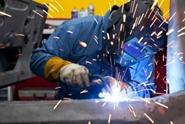Economy

Manufacturing Continues to Expand in Texas and Richmond Regions
Written by Sandy Williams
April 27, 2016
Two Federal Reserve manufacturing indexes came out this week: the Texas Manufacturing Outlook Survey and the Richmond Fifth District Survey of Manufacturing. Both surveys show manufacturing continuing to expand in April.
Texas Manufacturing Outlook Survey
Manufacturers in Texas saw production output pick up slightly in April. The new orders index rebounded into positive territory at 6.2 after four months of negative readings. Capacity utilization and shipments both climbed to second positive reading in a row, at 8.2 and 7.1 respectively.
Texan firms remained pessimistic about broader business conditions, remaining at a negative reading for the 16th month. Company outlook improved from -11.09 to -5.9 in April indicating some stabilization.
The employment index reflected continued weakness in the region. Fourteen percent of firms reported new hiring while 18 percent reported layoffs in April. Wages and benefits showed a slight rise in compensation.
Pricing pressure were alleviated somewhat. The raw material prices index increased in April, bouncing back from negative numbers. Finished good also increased but failed, however, to emerge from negative numbers where it has been since January 2015.
Manufacturers in Texas gave mixed results on future business conditions. The future general business activity index fell 6 points to 0.4 while the company outlook index was at its third positive reading at 8.9. Other indexes for future manufacturing activity were solidly positive for the month.
Richmond Fifth District Survey of Manufacturing
The Fifth District saw firm manufacturing conditions in April with some softening of index components compared to March. The manufacturing composite index registered 14, down from 22. Shipments and new orders shed points from February’s strong results but were solid at 14 and 18, respectively.
Manufacturing employment increased modestly along with the average work week length. Wage increase moderated in April.
Backlogs increased 10 points while vendor lead times were flat. Capacity utilization improved by one point to 18. Inventories rose at a slower pace than March.
Manufacturers were still optimistic about future business conditions but were slightly more reserved. Solid growth is expected for new orders and shipments during the next six months. Backlogs are expected to increase gradually and capacity utilization is expected to rise at a slower rate. Modest increases in hiring and wages are anticipated. Prices paid and received are expected to rise faster in the next six months.

Sandy Williams
Read more from Sandy WilliamsLatest in Economy

New York state manufacturing index drops again in April
Firms were pessimistic, with the future general business conditions index falling to its second lowest reading in the more than 20-year history of the survey

Construction adds 13,000 jobs in March
The construction sector added 13,000 jobs, seasonally adjusted, in March, but tariffs could undermine the industry.

Supply chains, end-users brace for impact from tariffs
Supply chains are working through what the tariffs mean for them

ISM: Manufacturing expansion loses steam after two months of growth
US manufacturing activity slowed in March after two straight months of expansion, according to supply executives contributing to the Institute for Supply Management (ISM)’s latest report.

Chicago Business Barometer rose to 16-month high in March
The Chicago Business Barometer increased for the third-consecutive month in March. Despite this, it still reflects contracting business conditions, as it has since December 2023.
